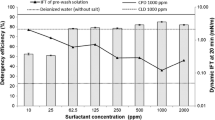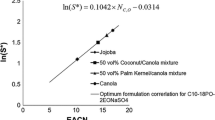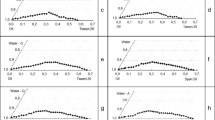Abstract
Microemulsion formation of triglyceride oils at ambient conditions (temperature and pressure) and without the addition of co-oil and/or alcohols is challenging at best. Undesirable phases, such as macroemulsions, liquid crystals and sponge phases, are often encountered when formulating triglyceride microemulsions. The purpose of this study is to investigate the use of extended surfactants, lipophilic linkers, and hydrophilic linkers in enhancing triglyceride solubilization and interfacial tension reduction. We have studied two classes of extended surfactants, linear alkyl polypropoxylated sulfate (LAPS) surfactants and linear alkyl polypropoxylated ethoxylated sulfate (LAPES) surfactants. Linkers evaluated were oleyl alcohol (lipophilic linker), sodium mono and dimethyl naphthalene sulfonate (SMDNS), and polyglucoside (hydrophilic linkers). Oils studied include olive, peanut, soybean, canola and sunflower oils. The effect of electrolyte concentration on microemulsion phase behavior was studied. The microemulsion “fish” diagram was obtained by plotting the total surfactant and linker concentrations versus the electrolyte concentration. We were able to form Winsor Type I, II, III and IV microemulsions at ambient conditions and without co-oil or short and medium chain length alcohol addition. Winsor Type III and IV triglyceride microemulsions are particularly useful in numerous applications such as cosmetics, vegetable oil extraction and soil remediation.







Similar content being viewed by others
References
Sabatini DA, Knox RC, Harwell JH, Wu B (2000) Integrated design of surfactant enhanced DNAPL remediation: efficient supersolubilization and gradient systems. J Contam Hydrol 45:99–121
Childs JD, Acosta E, Knox R, Harwell JH, Sabatini DA (2004) Improving the extraction of tetrachloroethylene from soil columns using surfactant gradient systems. J Contam Hydrol 71:27–45
Bourrel M, Schechter RS (1988) Microemulsions and related systems. Marcel Dekker, New York
Kukieda H (1989) Phase behaviors in water/nonionic surfactant/hydrocarbon and water/nonionic surfactant/amphiphilic oil system. J Colloid Interface Sci 133:237–243
Lindman B, Shinoda K, Olsson U, Anderson DM, Karlstrom G, Wennerstrom H (1989) On the demonstration of bicontinuous structures in microemulsions. Colloid Surf 38:205–224
Gelbart WM, Ben-Shaul A, Roux D (eds) (1994) Micelles, membranes, microemulsions and monolayers. Spinger, New York, pp 395–426
Joubran RF, Cornell DG, Parris N (1993) Microemulsions of triglyceride and non-ionic surfactant: effect of temperature and aqueous phase composition. Colloids Surf A 80:153–160
Corswant C, Engstrom S, Soderman O (1997) Microemulsions based on soybean phosphatidylcholine and triglycerides. phase behavior and microstructure. Langmuir 13:5061–5070
Tungsubutra T, Miller CA (1994) Effect of secondary alcohol ethoxylates on bahavior of triolein–water–surfactant systems. JAOCS 71(1):65–73
Huang L, Lips A (2004) Microemulsification triglyceride sebum and the role of interfacial structure on bicontinuous phase behavior. Langmuir 20:3559–3563
Corswant CV, Soderman O (1998) Effect of adding isopropyl myristate to microemulsions based on soybean phosphatidylcholine and triglycerides. Langmuir 14:3506–3511
Minana-Perez M, Graciaa A, Lachaise J, Salager JL (1995) Solubilization of polar oils with extended surfactants. Colloids Surf A Physicochem Eng Asp 100:217–224
Salager JL, Anton RE, Sabatini DA, Harwell JH, Acosta A, Tolosa LI (2005) Enhacing solubilization in microemulsions—state of the art and current trends. J Surfact Dterg 8:3–12
Withayyapayanon A, Acosta EJ, Harwell JH, Sabatini DA (2006) Formulation of ultralow interfacial tension systems using extended-surfactants. J Surfact Deterg 9:331–339
Minana-Perez M, Graciaa A, Lachaise J, Salager JL (1996) Systems containing mixtures of extended surfactants and conventional nonionics. Phase behavior and solubilization in microemulsion. In: Proc 4th World Surfactants Congr, Barcelona, Spain, 3–7 June 1996, 2:226–234
Minana-Perez M, Graciaa A, Lachise J, Salager JL (1995) Solubilization of polar oils in microemulsion systems. Progr Colloid Polym Sci 98:177–179
Sabatini DA, Acosta E, Harwell JH (2003) Linker molecules in surfactant mixtures. Curr Opin Colloid Interface Sci 8:316–326
Acosta E, Uchiyama H, Sabatini DA, Harwell JH (2002) The role of hydrophilic linkers. J Surfactants Deterg 5(2):151–157
Graciaa A, Lachaise J, Cucuphat C, Salager JL (1993) Improving solubilization in microemulsions with additives. 1. The lipophilic linker role. Langmuir 9:669–672
Graciaa A, Lachaise C, Cucupht C, Salager JL (1993) Improving solubilization in mciroemulsions with additives. 2. Long chain alcohols as lipophilic linkers. Langmuir 9:3371–3374
Acosta EJ, Le MA, Harwell JH, Sabatini DA (2003) Coalescense and solubilization kinetics in linker-modified microemulsions and related systems. Langmuir 19:566–574
Davies JT, Rideal EK (1961) Interfacial phenomena. Academic, New York
Davies JT (1957) A quantitative kinetic theory of emulsion type. I. Physical chemistry of the emulsifying agent. In: Schulman JH (ed) Proceedings of the 2nd International Congress of Surface Activity. Butterworths, London, 1:426–438
Poprawski J, Catte M, Marquez L, Salager JL, Aubry JM (2003) Application of hydrophilic-lipophilic deviation fromulation concept to microemulsions containing pine oil and nonionic surfactant. Polym Int 52:629–632
Witthayapayanon A, Harwell JH, Sabatini DA (2008) Hydrophilic-lipophilic deviation (HLD) method for characterizing conventional and extended-surfactants. J Colloid Interface Sci 325:259–266
Mori F, Lim JC, Raney OG, Elsik CM, Miller CA (1989) Phase behavior, dynamic contacting and detergency in systems containing triolein and nonionc surfactants. Colloids Surf 40(3–4):323–345
Cayias JL, Schechter RS, Wade WH (1976) Modeling crude oils for low interfacial tension. J Soc Pet Engr 16:351–357
Salager JL, Morgan JC, Schechter RS, Wade WH, Spe-Aime M, Vasquez E (1979) Optimum formulation of surfactant/water/oil systems for minimum interfacial tension or phase behavior. J Soc Petro Engr 19:107–115
Acosta E, Mai PD, Harwell JH, Sabatini DA (2003) Linker-modified microemulsion for a variety of oils and surfactants. J Surfact Deterg 6:1–12
Graciaa A, Lachaise J, Cucuphat C, Bourrel M, Salager JL (1993) Interfacial segregation of an ethyl oleate/hexadecane oil mixture in microemulsion systems. Langmuir 9:1473–1478
Komesvarakul N, Sanders MD, Szekeres E, Acosta EJ, Faller JF, Mentlik T, Fisher LB, Nicoll G, Sabatini DA, Scamehorn JF (2006) Microemulsions of triglyceride-based oils: the effect of co-oil and salinity on phase diagrams. J Cosmet Sci 55:309–325
Wan PJ, Wakelyn PJ (1997) Technology and solvents for extracting oilseeds and nonpetroleum oils. AOCS Press, Champaign, IL
Acknowledgments
The authors would like to thank George Smith, Hunstman Petrochemical Corp. (Houston, TX, USA) for providing us with the extended surfactant samples, and Cognis Care Chemicals for providing us with Glucopon N425. Funding for this work was provided through the United States Environmental Protection Agency’s “Science to Achieve Results” (STAR) program, through grant number Rd-83090301-0. Although the research described in this article was funded by the United States Environmental Protection Agency, it has not been subjected to the Agency’s required peer and policy review and therefore does not necessarily reflect the views of the Agency and no official endorsement should be inferred. Partial support was provided by industrial sponsors of the Institute for Applied Surfactant Research at the University of Oklahoma: Akzo Nobel, Clorox, Conoco/Phillips, Church and Dwight, Ecolab, Halliburton, Dow Chemicals, Huntsman, Oxiteno, Procter & Gamble, Sasol North America, Shell Chemical, Unilever, and from Dr. Sabatini’s Sun Oil Company-endowed chair and Dr. Harwell’s Conoco/Dupont-endowed professorship.
Author information
Authors and Affiliations
Corresponding author
About this article
Cite this article
Do, L.D., Withayyapayanon, A., Harwell, J.H. et al. Environmentally Friendly Vegetable Oil Microemulsions Using Extended Surfactants and Linkers. J Surfact Deterg 12, 91–99 (2009). https://doi.org/10.1007/s11743-008-1096-0
Received:
Accepted:
Published:
Issue Date:
DOI: https://doi.org/10.1007/s11743-008-1096-0




